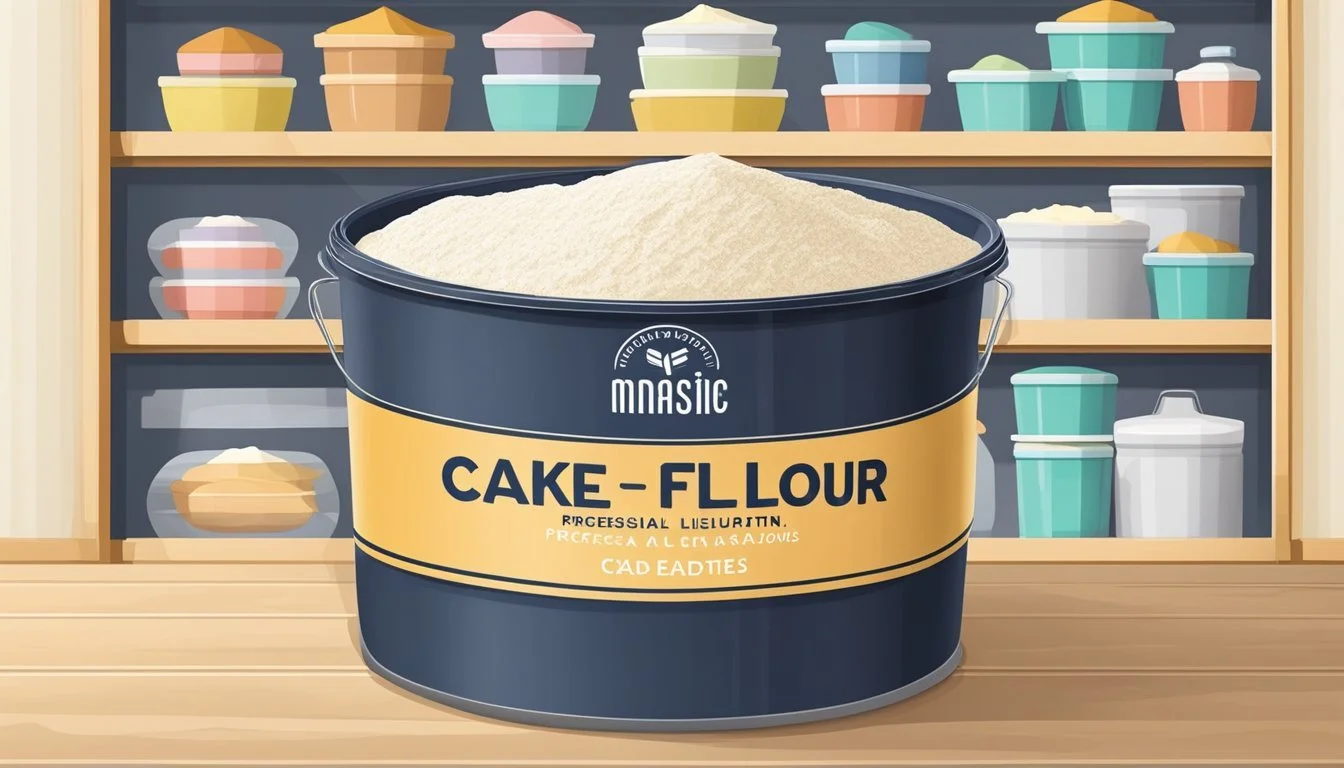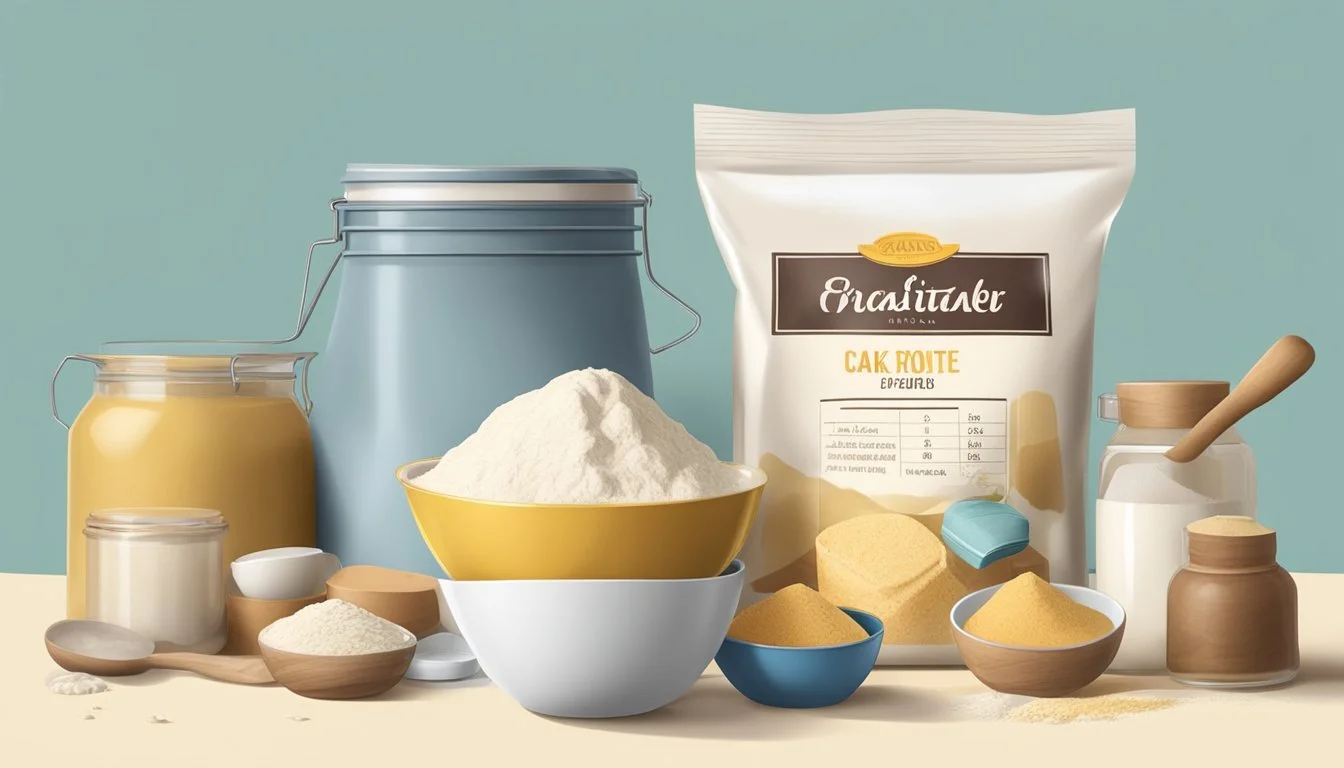Does Cake Flour Go Bad?
Shelf Life and Storage Tips
Cake flour, known for producing light and tender cakes, does have a shelf life that bakers need to be mindful of. When stored properly in a pantry, cake flour can last up to a year, while refrigeration can extend its usability to two years, and freezing can keep it good for up to three years. This timeline ensures that cakes made with it remain fluffy and delicate.
To maximize the shelf life of cake flour, it’s crucial to store it in a cool, dry place, ideally in an airtight container. Improper storage can lead to spoilage, evident through a rancid or sour odor, unusual clumping, or the presence of mold. Regularly checking the flour’s condition can prevent any baking disappointments.
By understanding these key aspects of cake flour storage and spoilage, bakers can ensure their ingredients remain fresh and their baked goods maintain their intended texture.
Understanding Cake Flour
Cake flour is a key ingredient for achieving a light, tender, and fluffy texture in cakes. Its unique composition sets it apart from other types of flour, which influences its specific baking properties.
Composition and Types
Cake flour is milled from soft wheat, which is low in protein. This low protein content results in lower gluten formation compared to all-purpose flour. Consequently, cakes baked with cake flour have a finer, softer crumb.
When comparing cake flour to whole wheat flour, it's important to note that whole wheat flour contains the bran, germ, and endosperm. Cake flour, being more refined, lacks the bran and germ. This absence reduces the fiber content but enhances the flour's ability to produce a delicate cake structure.
Cake flour is often bleached, which alters the starch and protein structure, making it more effective at binding fats and liquids. This results in a batter that can hold more sugar and liquid, leading to a moister cake. Unbleached cake flour is available, though it's less common.
Cake Flour vs. Other Flours
Compared to all-purpose flour, cake flour has a finer texture and lower protein content (typically 7-9%). All-purpose flour, with a protein content of around 10-12%, is more versatile but produces denser baked goods.
Self-rising flour combines all-purpose flour with baking powder and salt. While convenient, it cannot replicate the delicate texture of cake flour due to its higher protein content.
In contrast, gluten-free flours like almond flour and coconut flour lack gluten entirely. They require additional binding agents for the structure in gluten-free baking. Though not typically used for traditional cakes, they offer alternatives for those with gluten sensitivities.
Whole grain flours, including whole wheat flour and nut flours (such as almond flour), introduce more flavor and nutrition but can make cakes denser.
These differences highlight why cake flour is uniquely suited for creating light, tender cakes, emphasizing its role in achieving optimal baking results.
Signs of Spoilage
Cake flour can exhibit several signs when it has gone bad, including visual, textural, and sensory changes. Identifying these signs early can ensure the quality and safety of your baked goods.
Visual and Textural Changes
One of the first indicators that cake flour has gone bad involves visual and textural changes. Fresh cake flour is usually light and fluffy. When spoiled, it may develop clumps due to moisture exposure.
Discoloration is another sign. Cake flour normally has a consistent white or off-white color. If it turns yellow, brown, or shows any signs of mold, it is likely spoiled. Additionally, bad flour may appear to be infested with weevils or other pests, which can degrade the quality and safety of the flour.
Odor and Taste Detection
Spoiled cake flour also announces itself through changes in smell and taste. Fresh cake flour should have a neutral odor. If the flour smells rancid, sour, or musty, it is no longer good to use.
Taste also provides clues. A small pinch-taste test can reveal if the flour tastes off. If the flavor is bitter or has any off-notes, it indicates that the flour has likely exceeded its expiration date or has been exposed to unfavorable storage conditions. Baking with bad flour can negatively impact the taste and safety of your cakes.
Proper Storage Methods
Storing cake flour correctly ensures it stays fresh and extends its shelf life. These methods emphasize maintaining a cool, dry environment and using airtight containers for optimal preservation.
Best Practices for Pantry Storage
Cake flour can be stored in the pantry effectively if certain practices are followed. Airtight containers are preferred over the original packaging. The paper bags that flour typically comes in are not secure enough to protect against moisture and pests.
Place the containers in a cool and dry place, ideally towards the back of the pantry where temperature fluctuations are minimal. Avoid exposure to light and heat sources.
Using a plastic bag as an additional layer of protection inside the airtight container can further help in keeping the flour dry. Food safety is key, so make sure all storage containers are clean and dry before use.
Refrigeration and Freezing Options
Refrigerating or freezing cake flour can significantly extend its shelf life. Flour stored in the refrigerator can last up to two years, while in the freezer, it can last up to three years.
Always use airtight containers or heavy-duty plastic bags to protect against moisture and odors from other foods. When removing flour from the fridge or freezer, allow it to reach room temperature before use to prevent clumping.
Clearly labeling containers with the date of storage can help track usage and ensure freshness. Maintaining a consistent, cool temperature with minimal light exposure is crucial for long-term storage.
Understanding Expiration Labels
The labels on cake flour packages provide essential information for determining the quality and safety of the product. Knowing how to interpret these labels ensures you use the flour within its optimal time frame.
Label Interpretation and Food Safety
Expiration labels such as "sell-by," "best-by," and "expiration date" indicate the manufacturer’s recommendation on freshness and quality.
Sell-by Date: This is aimed at retailers to indicate how long a product should be displayed for sale. It does not necessarily mean the food is unsafe right after this date.
Best-by Date: This date suggests when a product will be at its best flavor or quality. It is not a safety date.
Expiration Date: This is the last date recommended for the use of the product while it's at peak quality. Using the product after this date might lead to reduced quality and potential food safety risks.
Proper storage, such as keeping flour in a cool, dry place in an airtight container, can prolong its usability and maintain its quality as recommended by USDA guidelines.
Expiration vs Best-By Date
Both "expiration date" and "best-by date" indicate different things.
Expiration Date: Typically found on perishable items, this is the point after which consumption might be unsafe. For cake flour, using it past this date might result in inferior baking results and potential spoilage signs.
Best-by Date: Found on a variety of products, this indicates the date until which the product will retain its best flavor and quality. For cake flour, it means the product is likely still fine to use after this date, but might not yield the best baking results.
Understanding these differences helps in making informed decisions and ensuring food safety in the kitchen.
Potential Health Hazards
Consuming spoiled cake flour can lead to various health issues. It is also crucial to be aware of insect infestations and how to prevent them to maintain food safety.
Effects of Consuming Spoiled Flour
Spoiled cake flour may contain rancid flour, mold, and potentially harmful mycotoxins.
When ingested, such flour can cause vomiting, diarrhea, and other gastrointestinal issues. The off or sour smell of rancid flour is an indicator it has gone bad. While rancidity itself may not be harmful in small amounts, prolonged consumption can lead to health complications.
Flour with visible mold should be discarded immediately. Mold spores can produce mycotoxins, which pose a serious risk to health. Common symptoms of mycotoxin poisoning include nausea and vomiting. It's essential to avoid any flour with signs of spoilage to ensure food safety.
Insect Infestation and Prevention
Cake flour is highly susceptible to infestations by pests such as weevils, bugs, and other insects.
To prevent these infestations, store flour in airtight containers in a cool, dry place. Regularly inspect the flour for any signs of pests. Visible insects or small holes in the packaging indicate a problem.
If an infestation is found, it is best to discard the entire batch to prevent further food waste and contamination. Freezing flour for 48 hours before storage can also kill any existing eggs, further preventing infestations.
Maintaining proper food safety practices such as proper storage, regular inspection, and immediate disposal of infested flour is crucial in preventing health hazards and ensuring the high quality of your baking ingredients.
Impact on Baking and Recipes
Expired cake flour can significantly affect both the taste and texture of baked goods. Bakers must understand how the quality of the flour impacts recipes and what adjustments are necessary to achieve desirable results.
Quality of Baked Goods
When cake flour goes bad, it loses its ability to lend a tender, fluffy texture to baked goods.
Stale flour can produce cakes and cookies that are dense or have an off taste. The fat, oils, and moisture in the flour may become rancid, imparting a sour or musty flavor.
This degradation also affects the flour's structure, leading to less fluffy cakes and cookies. Proper storage in a cool, dry place can prolong its usability, but once quality deteriorates, the effect on baked goods is noticeable in both taste and texture.
Adjustments in Recipes
If using older cake flour, bakers may need to make adjustments to their recipes.
They might need to increase or decrease liquid ingredients to balance moisture levels. Adding a bit of fresh flour may help restore some of the lost structure and fluffiness.
Taste and flavor can be somewhat improved by incorporating stronger flavorings or spices to mask any subtle off-tastes from aging flour.
Always check for freshness and if in doubt, consider blending old and new flour to mitigate potential downsides. Ensuring all other ingredients are fresh can also help maintain the quality of the baked goods.
Alternative Uses for Old Flour
Even if cake flour has expired, it doesn't have to be wasted. There are several creative and practical applications for old flour that can prevent unnecessary waste and find useful purposes around the home.
Creative and Practical Applications
Expired flour can be effectively used in craft projects. It can be a key ingredient in making homemade clay or play dough for children. Flour-based glue can also be made by mixing flour with water, which can be used for paper-mâché projects or other crafting endeavors.
In gardening, old flour can be composted. Mixing flour into the compost heap provides additional nutrients, helping decompose other materials faster. This is a sustainable way to recycle expired food products and improve soil quality for future plant growth.
In household cleaning, old flour can be used to make a simple kitchen cleaner. When paired with salt, it helps scrub and polish stainless steel or copper cookware. This is an eco-friendly cleaning alternative that reduces the reliance on chemical-based cleaners.
By finding new uses for expired cake flour, it's possible to reduce food waste and adopt more sustainable household practices.







